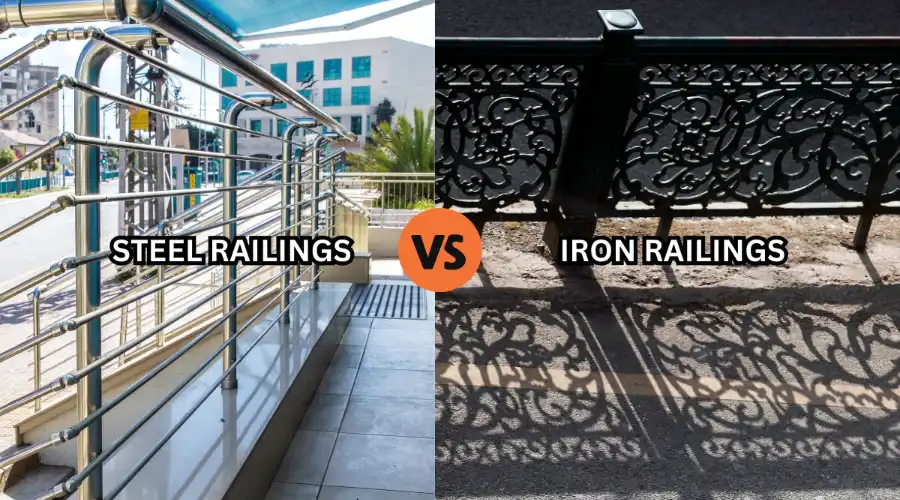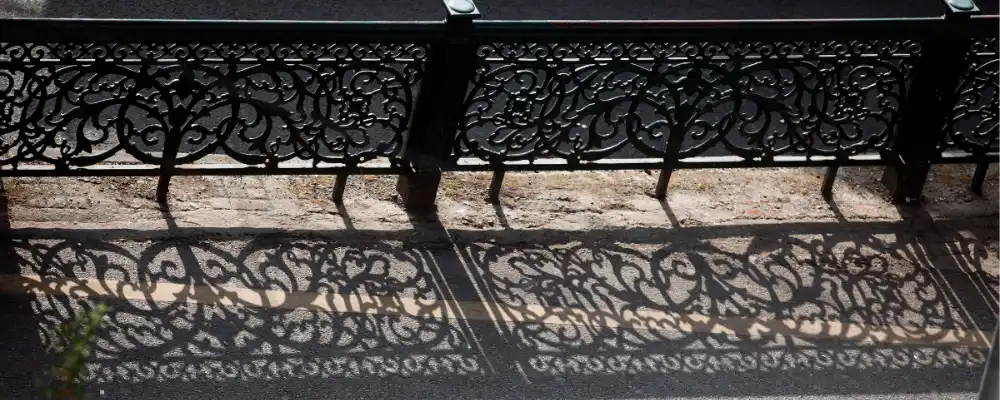In contemporary construction, individuals select Iron railings for their building projects to beautify buildings, staircases, and balconies for centuries. It is well known for giving both functional safety elements and timeless beauty. The best part is, that it can be ideal for returning a building to its original historical form or building a new modern house, giving a tried-and-tested option that is secure without losing style.
Here, we are going to discuss iron railing and its crucial facts, such as benefits, uses, varieties and many more to assist in selecting the optimal iron railing for your building work.
What is Iron Railing?
An iron railing serves both as a protective barrier and a design element, crafted primarily from iron. It usually comprises individual vertical balusters (the stanchions or uprights) joined by rails at the upper and lower regions, forming an impenetrable barrier for preventing falls as well as segregating areas. Iron railings may be utilitarian or designed with scrolls, twists, and ornaments, as desired and warranted by the purposes and the type of look aimed for.
Benefits of Iron Railing
Durability
Iron railings are highly resilient and stand the test of time for generations with little maintenance. They can withstand heavy loads, external force, and harsh weather, maintaining their strength and shape over time. In contrast to wood that deforms or decays, iron maintains its shape and usability for decades, hence a more worthwhile long-term investment for any property.
Low Maintenance
It is easy to maintain iron railing as it requires occasional cleaning. Newer models have factory-applied rust- and corrosion-resistant protective coatings. In case of damage, minor touch-up paint can revive the look without the need for replacing large sections.
Aesthetically Pleasing
Iron railings add architectural beauty through the classic charm and design flexibility that endures as long as steel. It comes in innumerable designs from minimalist lines to complex scrollwork. The high finishing possibilities enable iron railings to complement adjacent features smoothly or stand boldly against them.
Versatility
They adapt seamlessly to different settings, making them a reliable choice for both exterior and interior installations. Due to their high strength-to-weight ratio, they allow for elegant, minimal designs without sacrificing durability. Iron is extremely malleable, enabling fabricators to create bespoke shapes for unusual spaces like curved staircases or unusual-shaped balconies.
Types of Iron Railings
Wrought Iron Railings
Wrought iron balustrades are made through hand-forging and heating of the metal, which creates an original texture and character with details of slight fluctuation that reinforce craftsmanship.
- Composition: Fibrous slag inclusion, low-carbon iron (~0.08%)
- Yield Strength: ~250–350 MPa
- Strengths: Ductility, ease of hot working, fatigue resistance
- Application: Historic restoration, artistic railing, curved profile
Decorative Iron Railings
Decorative versions often include artistic features like finials, rosettes, leaves, baskets, and other intricate motifs that transform a simple guardrail into a visual statement.
- Composition: Generally mild steel or wrought iron; can incorporate cast iron features for decorative detailing
- Yield Strength: Mild Steel: ~250–400 MPa
- Strengths: Can have mixed fabrication methods (casting, forging, welding)
- Application: Custom gates, fences, and facade detailing for residential and commercial use.
Cast Iron Railings
Cast iron railings are produced by pouring molten iron into a mould, allowing the repeated reproduction of intricate designs with sharp detail.
- Composition: High-carbon alloy (~2.5%–4%)
- Ultimate Strength: 150–250 MPa (tension brittle)
- Benefit: Precision moulding, inexpensive mass replication
- Application: Decorative railing panels, heritage building restoration
Antique Iron Railings
Antique iron railings consist of both authentic pieces removed from older structures and new reproductions made to replicate period-style designs.
- Composition: Original antique railings tend to be genuine wrought iron; more recent reproductions will utilise cast iron or mild steel, replicating historic shapes
- Yield Strength: Wrought Iron (historic): ~250–350 MPa and Cast Iron (reproductions): ~150–200 MPa
- Benefit: Genuine appearance with hand-forged textures and ageing patina
- Application: Heritage building restoration
Applications of Iron Railings
Several applications of iron railings are as follows:
- Besides serving an architectural purpose, iron railings are also used on internal stairs within houses to avoid falls.
- They enhance the design of the building while serving as safety barriers on balconies to ensure security.
- Iron gates at commercial and residential entrances provide a dramatic visual effect, besides security.
- Iron fences are employed by restaurants and cafés to define and protect outdoor dining areas.
- Iron fences help to define borders and direct pedestrian circulation in public parks.
- Iron railings are installed on bridges to keep vehicles and pedestrians from slipping down.
- They must be installed on access ramps in public buildings and commercial establishments to meet ADA safety standards.
Steel Railings vs Iron Railings

Below, we explore some key differences that set iron railings apart from steel railings:
| Feature | Steel Railings | Iron Railings |
| Composition | Modern alloy with controlled carbon content | Wrought iron, with its fibrous slag texture, and cast iron, rich in carbon content |
| Strength | Higher tensile strength, better load capacity | Good compression strength, more brittle than steel |
| Weight | Lighter for the same strength profile | Typically heavier and more substantial |
| Corrosion Resistance | Better inherent rust resistance | Requires more diligent protection against rust |
| Welding Properties | Easier to weld and join | As it is more challenging to weld, traditional metal joinery techniques are frequently employed. |
| Cost | Generally more economical | Often more expensive, especially wrought iron |
| Appearance | Smoother, more uniform surface | More character, visible grain structure in wrought iron |
| Modern Availability | Widely available on many profiles | True wrought iron is limited; cast iron is readily available |
| Historical Accuracy | Less suitable for period restorations | Preferred for historical authenticity |
Installation of Iron Railings
Planning and Measuring
The exact measurement is essential before installation. Measure exact heights, lengths, and post locations based on your requirements and area building codes. Most codes demand railings between 36-42 inches in height with balusters to be placed in such a manner that a 4-inch sphere cannot pass through them.
Gathering Necessary Tools and Materials
Correct installation calls for specialized equipment, such as a hammer drill, masonry bits, level, measuring tape, wrench set, and anchor bolts suitable to your mounting surface. Expansion anchors or epoxy anchors offer solid hold points for concrete or brick installations.
Preparing the Mounting Surface
Clean and check the mounting surface for weakness or damage. For concrete, locate post positions accurately and drill holes with a hammer drill and the proper bit size for your anchors. For wood mounting, find and mark structural framing members, not merely decorative ones.
Securing Posts
Mount the first and final posts with proper anchors, making sure they are completely plumb with a level. Temporary bracing is sometimes necessary. On concrete or brick surfaces, drive anchors into pre-drilled holes and tighten as specified by the manufacturer.
Attaching Rails and Balusters
Join horizontal rails to the anchored end posts, ensuring level mounting. Install intermediate posts using the same anchoring procedure. Add balusters at proper distances, ensuring uniform alignment and solid connection throughout the entire railing system.
Finishing and Protection
Upon installation, touch up paint or protective coating on any damaged area where the original finish was compromised during installation. Seal exposed cut ends and points of connection to avoid moisture intrusion and rust buildup, prolonging the lifespan of your iron railings.
Conclusion
Iron railings are still unrivalled in their capacity to provide functional safety with long-lasting style. Their exceptional strength, design flexibility, and classic appeal make them an excellent option for beautifying both homes and businesses. From traditional sophistication to contemporary chic, iron railings provide beauty that endures for generations. For professional advice and impeccable installation, call Brick & Bolt today and beautify your property with bespoke iron railing solutions.

